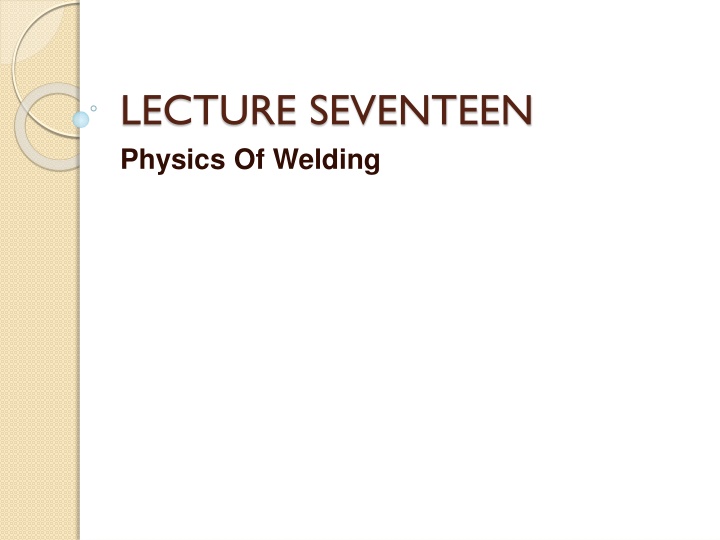
Understanding the Importance of Power Density in Welding Processes
Explore the significance of power density in welding, the impact of heat energy on faying surfaces, and the effects of varying power densities on metal melting. Learn about the practical range of power densities for efficient welding operations.
Download Presentation

Please find below an Image/Link to download the presentation.
The content on the website is provided AS IS for your information and personal use only. It may not be sold, licensed, or shared on other websites without obtaining consent from the author. If you encounter any issues during the download, it is possible that the publisher has removed the file from their server.
You are allowed to download the files provided on this website for personal or commercial use, subject to the condition that they are used lawfully. All files are the property of their respective owners.
The content on the website is provided AS IS for your information and personal use only. It may not be sold, licensed, or shared on other websites without obtaining consent from the author.
E N D
Presentation Transcript
LECTURE SEVENTEEN Physics Of Welding
POWER DENSITIES We first examine the issue of power density and its importance, and then we define the heat and power equations that describe a welding process. To accomplish fusion, a source of high-density heat energy is supplied to the faying surfaces, and the resulting temperatures are sufficient to cause localized melting of the base metals. If a filler metal is added, the heat density must be high enough to melt it also. Heat density can be defined as the power transferred to the work per unit surface area, W/mm2 (Btu/sec-in2). The time to melt the metal is inversely proportional to the power density. At low power densities, a significant amount of time is required to cause melting
If power density is too low, the heat is conducted into the work as rapidly as it is added at the surface, and melting never occurs. It has been found that the minimum power density required to melt most metals in welding is about 10 W/mm2(6 Btu/sec-in2). As heat density increases, melting time is reduced. If power density is too high above around 105 W/mm2(60,000 Btu/secin2), the localized temperatures vaporize the metal in the affected region. Thus, there is a practical range of values for power density within which welding can be performed.
Differences among welding processes in this range are (1) The rate at which welding can be performed and/or (2) The size of the region that can be welded As example Oxyfuel gas welding is capable of developing large amounts of heat, but the heat density is relatively low because it is spread over a large area. For metallurgical reasons, it is desirable to melt the metal with minimum energy, and high power densities are generally preferable. Power density can be computed as the power entering the surface divided by the corresponding surface area: ?? =? ? Where PD = power density, W/mm2(Btu/sec-in2); P = power entering the surface,W (Btu/sec); and A= surface area over which the energy is entering, mm2 (in2). 17.1
The issue is more complicated than indicated by Eq. (17.1). One complication is that the power source (e.g., the arc) is moving in many welding processes, which results in preheating ahead of the operation and postheating behind it. Another complication is that power density is not uniform throughout the affected surface; it is distributed as a function of area, as demonstrated by the following example.
EXAMPLE1: A heat source transfers 3000W to the surface of a metal part. The heat impinges the surface in a circular area, with intensities varying inside the circle. The distribution is as follows: 70% of the power is transferred within a circle of diameter=5mm, and 90%is transferred within a concentric circle of diameter = 12 mm. What are the power densities in (a) the 5-mm diameter inner circle and (b) the 12-mm-diameter ring that lies around the inner circle?
EXAMPLE2: A welding heat source is capable of transferring 150 Btu/min to the surface of a metal part. The heated area is approximately circular, and the heat intensity decreases with increasing radius as follows: 50% of the power is transferred within a circle of diameter = 0.1 inch and 75% is transferred within a concentric circle of diameter = 0.25 in. What are the power densities in (a) the 0.1-inch diameter inner circle and (b) the 0.25-inch diameter ring that lies around the inner circle? (c) Are these power densities sufficient for melting metal? Solution: (a) Area A = (0.1)2/4 = 0.00785 in2 150 Btu/min = 2.5 Btu/sec. Power P = 0.50(2.5) = 1.25 Btu/sec Power density PD = (1.25 Btu/sec)/0.00785 in2 = 159 Btu/sec-in2 (b) A = (0.252 - 0.12)/4 = 0.0412 in2 Power P = (0.75 - 0.50)(2.5) = 0.625 Btu/sec Power density PD = (0.625 Btu/sec)/0.0412 in2 = 15.16 Btu/sec-in2 (c) Power densities are sufficient certainly in the inner circle and probably in the outer ring for welding.






















